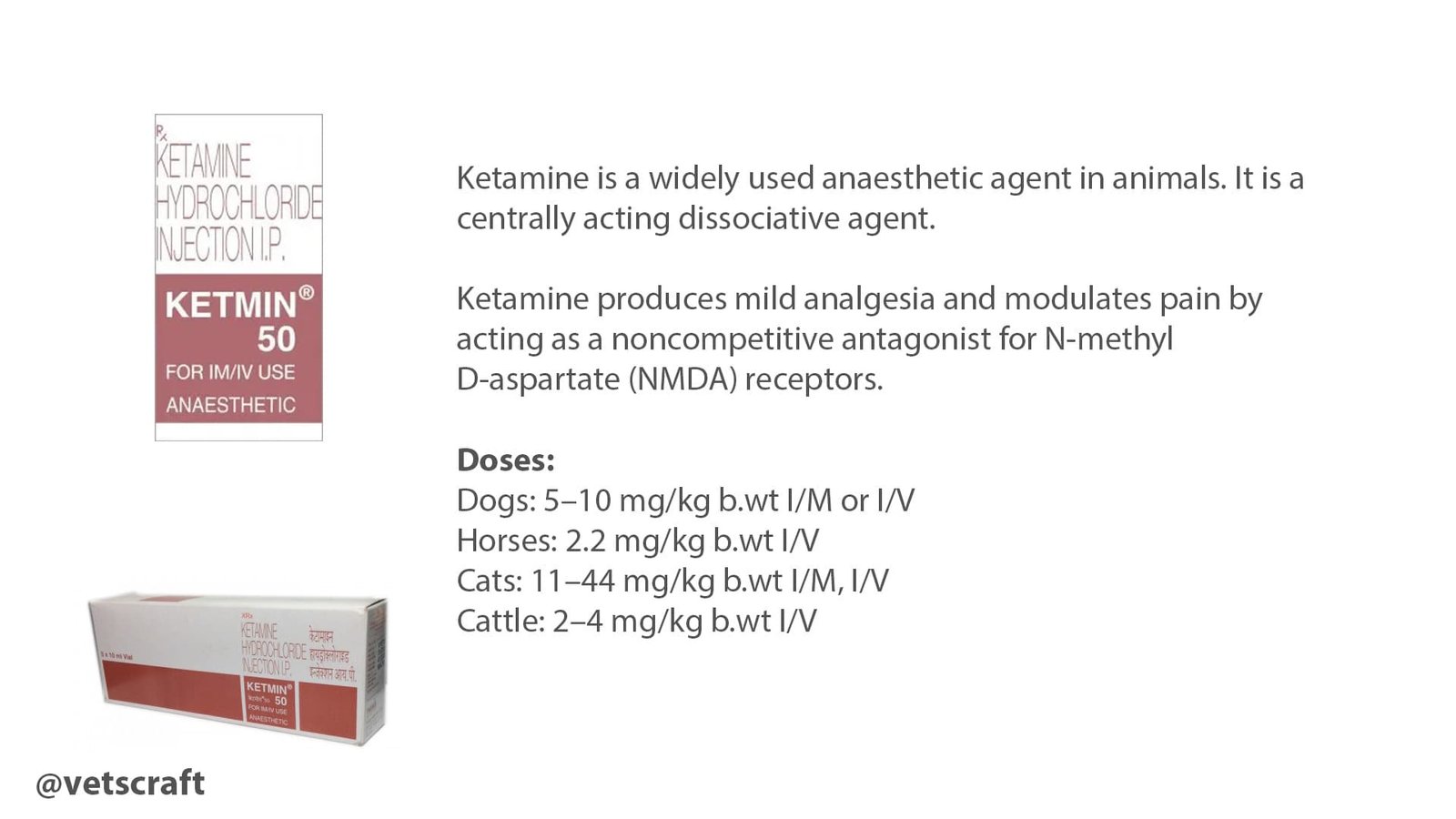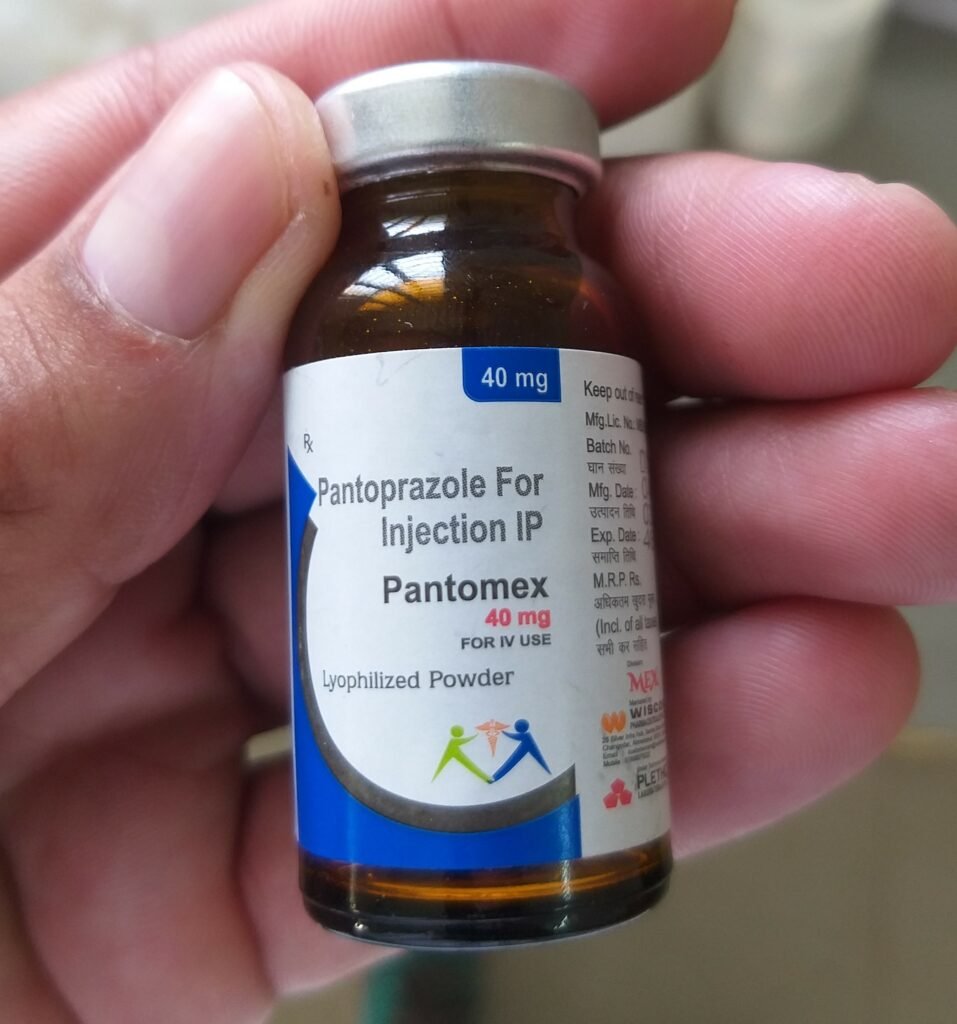TABLE OF CONTENTS
Ketamine
Ketamine is a widely used anaesthetic agent in animals. It is a centrally acting dissociative agent.
Group
Ketamine is grouped as an anaesthetic agent (dissociative anaesthetic agent).
Mechanism of Action
Ketamine produces mild analgesia and modulates pain by acting as a noncompetitive antagonist for N-methyl D-aspartate (NMDA) receptors.
Ketamine is not active by PO route. It must be injected by IV, IM, or SQ routes. It has a short half-life in most animals (60–90 minutes) and is rapidly metabolised, so you need to give it frequently while operating.
Dose Rates
The dose rate for ketamine hydrochloride in various animals is given below:
- Dog and Cats: 5-15 mg/kg body weight as patient recover during surgery by IV or IM
- Horse, Cattle, Swine, Sheep and Goats: 2-3mg/kg body weight by IV or IM
*A lower dose is used for IV and a higher dose is used for IM route.
Indications
Ketamine hydrochloride is used in these cases-
- Short-term anaesthetic procedures
- Restraint purpose
Contraindications
Ketamine is contraindicated in the following conditions-
- Patients with Epilepsy
- Animals prone to seizures
- Pregnant animals
Interactions
- Ketamine is often combined with other anaesthetics and sedatives, such as benzodiazepines (diazepam), propofol, opiates, and alpha2-agonists (xylazine). Such combinations have been synergistic and allowed lower doses of each individual component
- Ketamine may cause vomiting with Alpha-2 agonists (xylazine)
Adverse effects
- Ketamine causes pain with an IM injection
- Tremors, muscle spasticity, and convulsive seizures
- Ketamine increases sympathetic tone, heart rate, and blood pressure
Toxicity
Spontaneous movements, salivation, and increased body temperature are more common in dogs when high doses of ketamine are used.
The majority of ketamine overdose or toxicity therapy consists of supportive care, while more serious cases could need placing the patient on a monitor.If breathing assistance is required, intubation may be utilised. There are currently no recognised medications that can reverse a ketamine overdose.
Preparations
Ketamine hydrochloride comes in injection forms in 10mg/mL, 50 mg/mL and 100 mg/mL preparations. Some of the preparations are mentioned below-
- Inj. Ketmin 10mL vial contains 50mg/mL ketamine HCl
- Inj. Aneket 10mL vial contains 50mg/mL ketamine HCl
Instead of these, ketamine is available by the brand names Zokent, Ketaset, Ketalar, Ketavet, Vetalar, Ketadex, etc. across the globe.
More about Ketamine hydrochloride for animals
- Ketamine also binds to opioid N receptors and sigma receptors
- Ketamine produces a loss of sensory perception of response and a state of altered consciousness (coma like) often referred to as CATALEPTOID ANAESTHESIA, which differ markedly from the classic signs of anaesthesia produced by volatile gases anaesthetics and barbiturates
- In ketamine anaesthesia, the eyes remain open with active corneal and pupillary light reflexes suggesting that the mechanisms involved in dissociative anaesthesia are different from those of inhalant anaesthetics
- Ketamine appears to alter the reactivity of the CNS to various sensory impulses without blocking the sensory input at spinal or brain stem levels. The input may reach cortical receiving areas, but it fails to be perceived because of the associated areas during anaesthesia.
- Ketamine is a clear colourless, odourless solution soluble in water and commercially available as a 1% (10 mg/ml) and 5% (50 mg/ml) solutions
- The solution has a pH of 3.7 and is an irritant when given intramuscularly
- Ketamine is a potent convulsant and may induce seizures when used alone
- Ketamine increases intracranial and intraocular pressure
- Ketamine increases the respiratory rate but the tidal volume is decreased
- Ketamine produce apneutic pattern of breathing
- Xylazine in combination with ketamine improve muscle relaxation, the degree of visceral analgesia and recovery


